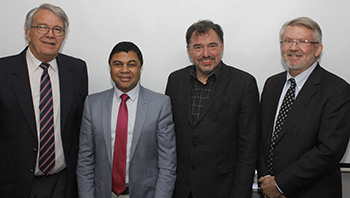International Bible scholars attend conference on Apocalyptic Literature and Mysticism

Prof Francis Petersen, UFS Rector and Vice-Chancellor,
second from left, flanked by three
deans of theology: Prof Fanie Snyman (UFS),
Prof Jörg Frey (University of Zurich),
and Prof Gregory Sterling (Yale Divinity School).
Photo: Eugene Seegers
Apocalypticism and mysticism have become two key areas of research that have converged to form the heart of contemporary spirituality. It was with this in mind that leading local and international Bible scholars were invited to a collaborative international conference jointly hosted by the UFS Faculty of Theology and Religion and Yale Divinity School, with the theme Apocalyptic Literature and Mysticism—Investigating a Turn in Recent Apocalyptic Research.
It is perhaps unknown to many that a number of the most profound thinkers, both of Judeo-Christian tradition and other religions in general, were mystics. Their lives and writings speak of a longing for an intimate relationship with God, reflecting on universal existential questions such as understanding our human existence, our creation, and ultimately, the meaning of life.
Apocalypticism, on the other hand, focuses on texts and prophecies describing how an alternative, future world might replace our existing one, a process often cataclysmic in nature, thus, like the mystics, also reflecting on the deeper foundations of human existence and our possible demise.
Traditionally, both have been misunderstood and controversial, but more recent research has revealed their formative role in religious discourses, with many scholars finding growing commonalities between apocalyptic and mystical texts. Moreover, these commonalities help to establish a better understanding of Judeo-Christian traditions, as well as other religions in general.
This hugely successful UFS collaborative effort, as well as others of its kind, contribute to the growth of theology as a discipline, with a positive impact on the broader religious community, the church, and society as a whole in the common desire for a just, equitable, and humane world.